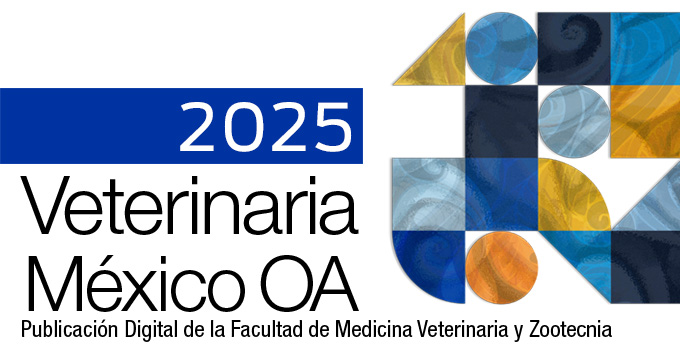Antimicrobial activity in vitro against Mannheimia haemolytica, Pasteurella multocida, and/or Histophilus somni from cattle with naturally occurring bovine respiratory disease and its association to clinical outcome
Main Article Content
Abstract
Antimicrobial resistance is frequently blamed for clinical failures of treatment or control of bovine respiratory disease (BRD). Mannheimia haemolytica, Pasteurella multocida, Histophilus somni, and Mycoplasma bovis are generally recognized as the four main bacterial pathogens associated with BRD. This study used data from randomized, controlled, clinical trials that recorded qualitative classification of clinical outcomes (success, or failure) and of results of antimicrobial susceptibility testing (AST; classified as resistant, or not resistant to florfenicol, gamithromycin, tildipirosin, or tulathromycin). Association of results in vitro to clinical outcome for treatment or control of naturally occurring BRD (1 319 calves) was quantitatively evaluated. Clinical outcome was not significantly (P = 0.4643) associated (Fisher’s exact test) with qualitative results of AST in vitro for pathogens that were not exposed to antimicrobial medication in vivo (971 head of cattle). Clinical outcome was significantly (P < 0.0001) associated with qualitative results of AST in vitro for pathogens that were exposed to antimicrobial medication in vivo (348 head of cattle). For pathogens not exposed to antimicrobial medication in vivo, 1.85 % (95 % confidence interval [CI] = 0.38 to 5.32) of clinical failures were attributable to antimicrobial resistance. For pathogens exposed to antimicrobial medication in vivo, 51.72 % (95 % CI = 32.53 to 70.55) of clinical failures were attributable to antimicrobial resistance. In conclusion, antimicrobial resistance of bacterial pathogens associated with BRD and not exposed to antimicrobial medication in vivo is a quantitatively minor cause of clinical failure for treatment or control of naturally occurring BRD.
Article Details
References
Czuprynski CJ. Host response to bovine respiratory pathogens. Animal Health Research Reviews. 2009;10:141−143. doi: 10.1017/S1466252309990181.
Fulton RW. Bovine respiratory disease research (1983-2009). Animal Health Research Reviews. 2009;10:131−139.
Gershwin LJ, Van Eenennaam AL, Anderson ML, McEligot HA, Shao MX, Toaff-Rosenstein R, et al. Single pathogen challenge with agents of the bovine respiratory disease complex. PLoS ONE. 2015;10(11): e0142479. doi: 10.1371/journal.pone.0142479.
Grissett GP, White BJ, Larson RL. Structured literature review of responses of cattle to viral and bacterial pathogens causing bovine respiratory disease complex. Journal of Veterinary Internal Medicine. 2015;29:770−780.
Klima CL, Zaheer R, Cook SR, Booker CW, Hendrick S, Alexander TW, et al. Pathogens of bovine respiratory disease in North American feedlots conferring multidrug resistance via integrative conjugative elements. Journal of Clinical Microbiology. 2014;52:438−448.
Taylor JD, Fulton RW, Lehenbauer TW, Step DL, Confer AW. The epidemiology of bovine respiratory disease: what is the evidence for predisposing factors? Canadian Veterinary Journal. 2010;51:1095−1102.
Miles DG. Overview of the North American beef cattle industry and the incidence of bovine respiratory disease (BRD). Animal Health Research Reviews. 2009;10:101−103.
Smith RA, Step DL, Woolums AR. Bovine respiratory disease. Looking back and looking forward, what do we see? Veterinary Clinics of North America: Food Animal Practice. 2020;36:239−251.
Coetzee JF, Magstadt DR, Sidhu PK, Follett L, Schuler AM, Krull AC, et al. Association between antimicrobial drug class for treatment and retreatment of bovine respiratory disease (BRD) and frequency of resistant BRD pathogen isolation from veterinary diagnostic laboratory samples. PloS ONE. 2019; 14:e0219104. doi: 10.1371/journal.pone.0219104.
American Association of Bovine Practitioners. AABP Judicious therapeutic use of antimicrobials in cattle. March 2019. https://aabp.org/Resources/AABP_Guidelines/AABP_Judicious_Therapeutic_Use_of_Antimicrobials_Guideline%20-%202019.pdf
Canadian Veterinary Medical Association. Veterinary Oversight of Antimicrobial Use – A Pan-Canadian Framework of Professional Standards for Veterinarians. January 2021. https://www.canadianveterinarians.net/policy-and-outreach/position-statements/statements/antimicrobial-stewardship-in-veterinary-medicine
Frey E, Jacob M. Using antibiograms to promote antimicrobial stewardship during treatment of bacterial cystitis and superficial bacterial folliculitis in companion animal practice. Journal of the Veterinary Medical Association. 2020;257:900−903
Frey E, Jacob M. Development of a method for creating antibiograms for use in companion animal private practices. Journal of the Veterinary Medical Association. 2020;257:950−960.
Turnidge J, Paterson DL. Setting and revising antibacterial susceptibility breakpoints. Clinical Microbiology Reviews. 2007;20:391−408.
Watts JL, Sweeney MT. Antimicrobial resistance in bovine respiratory disease pathogens: Measures, trends, and impact on efficacy. Veterinary Clinics of North America: Food Animal Practice. 2010;26:79−88.
McClary DG, Loneragan GH, Shryock TR, Carter BL, Guthrie CA, Corbin MJ, et al. Relationship of in vitro minimum inhibitory concentrations of tilmicosin against Mannheimia haemolytica and Pasteurella multocida and in vivo tilmicosin treatment outcome among calves with signs of bovine respiratory disease. Journal of the Veterinary Medical Association. 2011;239:129−135.
Sarchet JJ, Pollreisz JH, Bechtol DT, Blanding M, Saltman RL, Taube PC. Limitations of bacterial culture, viral PCR, and tulathromycin susceptibility test methods from upper respiratory tract samples in predicting the outcome of tulathromycin control or treatment of bovine respiratory disease in high risk feeder heifers. bioRxiv. 2021; Posted February 4, 2021. doi: 10.1101/2021.02.04.429716.
Snyder E, and Credille B. Mannheimia haemolytica and Pasteurella multocida in bovine respiratory disease: How are they changing in response to efforts to control them? Veterinary Clinics Food Animal. 2020;36:253−268. doi: 10.1016/j.cvfa.2020.02.001
Clinical and Laboratory Standards Institute. Performance standards for antimicrobial disk and dilution susceptibility tests for bacteria isolated from animals. 4th ed. CLSI supplement VET08. Wayne, PA: Clinical and Laboratory Standards Institute, 2018.
Leclercq R, Cantón R, Brown DFJ, Giske CG, Heisig P, MacGowan AP, et al. EUCAST expert rules in antimicrobial susceptibility testing. Clinical Microbiology and Infection. 2013;19:141−160.
Ängeby K, Giske CG, Juréen P, Schön T. Wild-type MIC distributions must be considered to set clinically meaningful susceptibility testing breakpoints for all bacterial pathogens, including Mycobacterium tuberculosis. Antimicrobial Agents and Chemotherapy. 2011;55:4492−4493.
Pantozzi FL, Ibar MP, Nievas VF, Vigo GB, Moredo FA, Giacoboni GI. Wild-type minimal inhibitory concentration distributions in bacteria of animal origin in Argentina. Revista Argentina de Microbiología. 2014;46:34−40.
DeDonder KD, Apley MD. A literature review of antimicrobial resistance in pathogens associated with bovine respiratory disease. Animal Health Research Reviews. 2015;16:125−134. doi: 10.1017/S146625231500016X.
Portis E, Lindeman C, Johansen L, Stoltman G. A ten-year (2000-2009) study of antimicrobial susceptibility of bacteria that cause bovine respiratory disease complex – Mannheimia haemolytica, Pasteurella multocida, and Histophilus somni in the United States and Canada. Journal of Veterinary Diagnostic Investigation. 2012;24:932−944.
Crosby WB, Karish BB, Hiott LM, Pinnell LJ, Pittman A, Frye JG, Jackson CR, Loy JD, Epperson WB, Blanton J Jr, Capik SF, Morley PS, and Woolums AR. Tulathromycin metaphylaxis increases nasopharyngeal isolation of multidrug resistant Mannheimia haemolytica in stocker heifers. Frontiers in Veterinary Science. 2023. 10:1256997. doi: 10.3389/fvets.2023.1256997.
USDA. Feedlot 2011, Part IV: Health and Health Management on U.S. Feedlots with a Capacity of 1,000 or More Head. USDA-APHIS- VS-NAHMS, Fort Collins, CO, #638.0913 September 2013; http://www.aphis.usda.gov/nahms
FOI Summary. Original New Animal Drug Application (NADA) 141-063. Nuflor® Florfenicol https://animaldrugsatfda.fda.gov/adafda/views/#/foiDrugSummaries#foiApplicationInfo
FOI Summary. Original New Animal Drug Application (NADA) 141-328. Zactran® Gamithromcyin https://animaldrugsatfda.fda.gov/adafda/views/#/foiDrugSummaries#foiApplicationInfo
FOI Summary. Original New Animal Drug Application (NADA) 141-334. Zuprevo® Tildipirosin 18% Injectable Solution. https://animaldrugsatfda.fda.gov/adafda/views/#/foiDrugSummaries#foiApplicationInfo 30. FOI Summary. Original New Animal Drug Application (NADA) 141-244. Draxxin® Tulathromycin https://animaldrugsatfda.fda.gov/adafda/views/#/foiDrugSummaries#foiApplicationInfo
Straus SE, Richardson WS, Glasziou P, Haynes RB. Diagnosis and screening. In: Straus SE, Richardson WS, Glasziou P, Haynes RB, editors. Evidence-based Medicine: How to Practice and Teach EBM. 3rd ed. London: Elsevier Churchill Livingstone; 2005. p. 67−99.
Tessman R. Minimum inhibitory concentrations: What do they mean and how to apply them to make clinical decisions about BRD. Proceedings of the Academy of Veterinary Consultants; Spring meeting, April 2014. San Antonio, TX.
Rose M. Interpretive Criteria for Tildipirosin for Bovine and Swine Respiratory Disease. MSD Animal Health Innovation GmbH, a member of the Merck Animal Health group. Submitted to Clinical and Laboratory Standards Institute, Subcommittee on Veterinary Antimicrobial Susceptibility Testing; January 9−10, 2014. San Antonio, TX.
DeDonder K. Antimicrobial resistance and bovine respiratory disease; A pharmacokinetic/pharmacodynamic approach to macrolide resistance. P 74-81. [PhD Dissertation]. Department of Diagnostic Medicine/Pathobiology, College of Veterinary Medicine, Kansas State University, Manhattan, Kansas, USA; 2016.
Van Donkersgoed J, Berg J. Determination of bacterial pathogens related to bovine respiratory disease and antimicrobial susceptibility patterns in feedlot calves. Study report 41-AH105-ZRNU-M-2015. 2016. Data available from Merck Animal Health by request.
Van Donkersgoed J, Berg J. Determination of bacterial pathogens related to bovine respiratory disease and antimicrobial susceptibility patterns in feedlot calves. Study report 41-AH114-ZRNU-M-2016. 2017. Data available from Merck Animal Health by request.
Bossuyt PM, Reitsma JB, Bruns DE, Gatsonis CA, Glasziou PP, Irwig L, et al. (for the STARD Group). Stard 2015: An updated list of essential items for reporting diagnostic accuracy studies. British Medical Journal. 2015;351:h5527. doi: 10.1136/bmj.h5527.
MedCalc Software Ltd. Diagnostic test evaluation calculator. https://www.medcalc.org/calc/diagnostic_test.php. (Version 20.113)
Leeflang MMG, Rutjes AWS, Reitsma JB, Hooft L, Bossuyt PMM. Variation of a test’s sensitivity and specificity with disease prevalence. Canadian Medical Association Journal. 2013;185: E537−544.
Mercaldo ND, Lau KF, Zhou XH. Confidence intervals for predictive values with an emphasis to case-control studies. Statistics in Medicine. 2007;26:2170−2183. doi: 10.1002/sim.2677.
Helman SK, Mummah RO, Gostic KM, Buhnerkempe, MG, Prager KC, Lloyd-Smith JO. Estimating prevalence and test accuracy in disease ecology: How Bayesian latent class analysis can boost or bias imperfect test results. Ecology and Evolution. 2020;10:7221−7232. doi: 10.1002/ece3.6448.
Buczinski S. Diagnostic test use in cattle: Where are we? Where are we going? Proceedings of the Academy of Veterinary Consultants; Winter meeting, December 2017, Kansas City, MO.
Anholt RM, Klima C, Allan N, Matheson-Bird H, Schatz C, Ajitkumar P, et al. Antimicrobial susceptibility of bacteria that cause bovine respiratory disease complex in Alberta, Canada. Frontiers in Veterinary Science. 2017;4:207−217.
Fulton RW, Confer AW. Laboratory test descriptions for bovine respiratory disease diagnosis and their strengths and weaknesses: Gold standards for diagnosis, do they exist? Canadian Veterinary Journal. 2012;53:754−761.
Khodakaram-Tafti A, López A. Immunohistopathological findings in lungs of calves naturally infected with Mycoplasma bovis. Journal of Veterinary Medicine Series A 2004;51:10−14. doi: 10.1111/j.1439-0442.2004.00596.x.
Narita M, Kimura K, Tanimura N, Arai S, Tsuboi T, Katsuda K. Immunohistochemical characterization of calf pneumonia produced by the combined endobronchial administration of bovine Herpesvirus 1 and Pasteurella haemolytica. Journal of Comparative Pathology 2000;123:126−134.
Bhatt K, Timsit E, Rawlyk N, Potter A, Liljebjelke K. Integrative conjugate element ICEHs1 encodes for antimicrobial resistance and metal tolerance in Histophilus somni. Frontiers in Veterinary Science. 2018;5:153.
Cameron A, Zaheer R, McAllister TA. Emerging variants of the integrative and conjugant element ICEMh1 in livestock pathogens: Structural insights, potential host range, and implications for bacterial fitness and antimicrobial therapy. Frontiers in Microbiology. 2019;10:2608. doi: 10.3389/fmicb.2019.02608.
Klima CL, Alexander TW, Hendrick S, McAllister TA. Characterization of Mannheimia haemolytica isolated from feedlot cattle that were healthy or treated for bovine respiratory disease. Canadian Journal of Veterinary Research. 2014;78:38−45.
Ellington MJ, Ekelund O, Aarestrup FM, Canton R, Doumith M, Giske C, et al. The role of whole genome sequencing in antimicrobial susceptibility testing of bacteria: Report from the EUCAST Subcommittee. Clinical Microbiology and Infection. 2017;23:2−22. doi: 10.1016/j.cmi.2016.11.012.
Valsesia G, Hombach M, Maurer FP, Courvalin P, Roos M, Böttger EC. The resistant-population cutoff (RCOFF): A new concept for improved characterization of antimicrobial susceptibility patterns of non-wild-type bacterial populations. Journal of Clinical Microbiology. 2015;53:1806−1811.
Valsesia G, Roos M, Böttger EC, Hombach M. A statistical approach for determination of disk diffusion-based cutoff values for systemic characterization of wild-type and non-wild-type bacterial populations in antimicrobial susceptibility testing. Journal of Clinical Microbiology. 2015;53:1812−1822.
Nguyen MH, Yu VL, Morris AJ, McDermott L, Wagener MW, Harrell L, et al. Antimicrobial resistance and clinical outcome of Bacterioides bacteremia: findings of a multicenter prospective observational trial. Clinical Infectious Diseases. 2000;30:870−876.
Rosenblatt-Farrell N. The landscape of antibiotic resistance. Environmental Health Perspectives 2009;117:A245-A250.
Giles C and Shuttleworth EM. The sensitivity of various bacteria to antibiotics during the years 1951 to 1956. Journal of Clinical Pathology 1958;11:185-189.
Brumbaugh GW. Will antimicrobial resistance of BRD pathogens impact BRD management in the future? Animal Health Research Reviews. 2014;15(2):175-177. https://doi.org/10.1017/S1466252314000279.
License

Veterinaria México OA by Facultad de Medicina Veterinaria y Zootecnia - Universidad Nacional Autónoma de México is licensed under a Creative Commons Attribution 4.0 International Licence.
Based on a work at http://www.revistas.unam.mx
- All articles in Veterinaria México OA re published under the Creative Commons Attribution 4.0 Unported (CC-BY 4.0). With this license, authors retain copyright but allow any user to share, copy, distribute, transmit, adapt and make commercial use of the work, without needing to provide additional permission as long as appropriate attribution is made to the original author or source.
- By using this license, all Veterinaria México OAarticles meet or exceed all funder and institutional requirements for being considered Open Access.
- Authors cannot use copyrighted material within their article unless that material has also been made available under a similarly liberal license.



